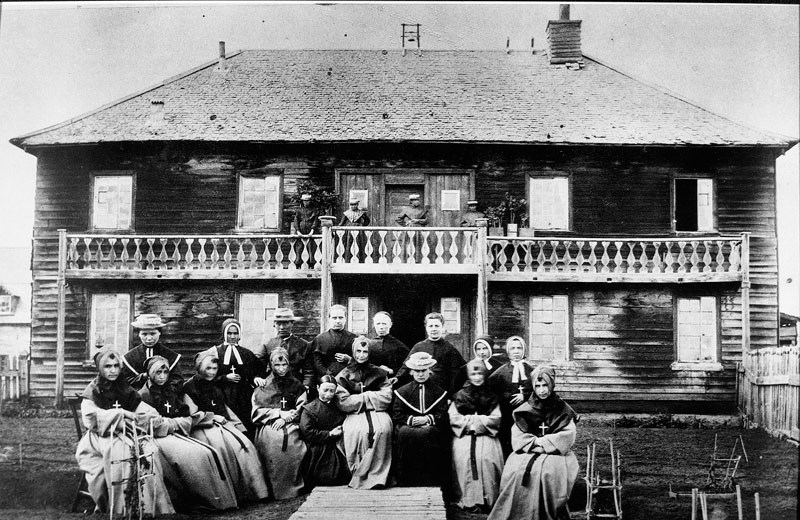Students might be on spring break, but local historians say they were just starting school in St. Albert some 150 years ago today.
March 23 is the 150th anniversary of the arrival of the Grey Nuns in St. Albert – specifically Sisters ZoĂ© Leblanc-Emery, Marie Jacques-Alphonse and AdÄŤle Lamy.
Greater St. Albert Catholic school students celebrated this anniversary earlier this week.
Father Albert Lacombe called the three nuns over from Lac Ste. Anne in 1863, said Louis Kloster, religious education consultant for the Catholic school division. Jacques-Alphonse was a teacher, and brought seven orphaned First Nations youth with her as students when she arrived on March 23.
“As soon as they arrived, they moved into a log house and they began teaching,” Kloster said.
That marked the start of the first permanent school in St. Albert, said Ray Pinco, chair of the St. Albert Historical Society. A Brother Scollen of the Oblates briefly taught classes here in 1862, Pinco noted, but soon left to start a school at Fort Edmonton.
The arrival of the nuns marked a major milestone in the community’s development, Pinco said.
“Villages and towns have trading posts, they’ve got stores, they’ve got a mill and they’ve got schools.”
By 1870, St. Albert had grown to about 700 residents, making it one of the biggest communities in the region.
The nuns and the seven orphans would have been crammed into a cold, drafty cabin maybe three-quarters of the size of the Father Lacombe Chapel, Pinco said.
“I doubt they would have had a board and a chalk,” he said, but they may have had a few books.
The students would have learned French, English, history, math and religion, Kloster said, as well as practical skills such as farming, weaving and spinning. Many of these courses are still being taught in local schools today, he noted.
The students moved into a bigger convent/orphanage/school in 1864, Pinco said, a picture of which can be found in The Black Robe’s Vision. Look closely, he notes, and you’ll see that the windows on it are actually cheesecloth, not glass. St. Albert wouldn’t get a dedicated school building until 1895.
St. Albert’s first permanent teacher, Jacques-Alphonse, was originally from QuĂ©bec, and would have been 28 when she arrived in this community, reads her official biography by the Grey Nuns. There are no photos of her in the Grey Nuns archives, but her official biography describes her as “very cheerful and industrious” with a “lively temperament.”
A pious and dedicated woman, Jacques-Alphonse was known to trek through the fields year-round to visit the poor and the abandoned, and would make and sell straw hats to raise funds for the community, her biography said. She would regularly recite the rosary, and had a blind orphan do it for her when she was busy doing laundry.
Jacques-Alphonse died in St. Albert on Oct. 7, 1879.
Just like today’s teachers, Jacques-Alphonse cared for every aspect of her students’ lives – spiritual, physical and mental, Kloster said.
“She was already looking after the whole child.”
Jacques-Alphonse, Leblanc-Emery and Lamy have their names carved on the Grey Nuns monument on Mission Hill. The former two are also buried there.
The Grey Nuns never left St. Albert after they arrived all those years ago, Pinco said.
“They themselves and their successors had a tremendous impact on our community.”
The Catholic division plans to celebrate the construction of the city’s first convent in September 2014, Kloster said.




